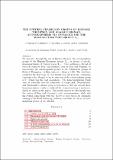The further chameleon groups of Richard Thompson and Graham Higman : automorphisms via dynamics for the Higman groups Gn,r
Abstract
We characterise the automorphism groups of the Higman groups Gn,r as groups of specific homeomorphisms of Cantor spaces Cn,r, through the use of Rubin's theorem. This continues a thread of research begun by Brin, and extended later by Brin and Guzmán: to characterise the automorphism groups of the 'Chameleon groups of Richard Thompson,' as Brin referred to them in 1996. The work here completes the first stage of that twenty-year-old program, containing (amongst other things) a characterisation of the automorphism group of V, which was the 'last chameleon.' As it happens, the homeomorphisms which arise naturally fit into the framework of Grigorchuk, Nekrashevich, and Suschanskiī's rational group of transducers, and exhibit fascinating connections with the theory of reset words for automata (arising in the Road Colouring Problem), while also appearing to offer insight into the nature of Brin and Guzmán's exotic automorphisms.
Citation
Bleak , C , Cameron , P , Maissel , Y , Navas , A & Olukoya , F 2022 , ' The further chameleon groups of Richard Thompson and Graham Higman : automorphisms via dynamics for the Higman groups G n,r ' , Memoirs of the American Mathematical Society . < https://arxiv.org/abs/1605.09302 >
Publication
Memoirs of the American Mathematical Society
Status
Peer reviewed
ISSN
0065-9266Type
Journal article
Description
Funding: The first and second authors wish to acknowledge support from EPSRC grant EP/R032866/1 received during the editing process of this article. The fourth author would like to thank St. Andrews University for its hospitality during the Workshop on the Extended Family of Thompson’s Groups in 2014, and acknowledges the support of DySYRF (Anillo Project 1103, CONICYT) and Fondecyt’s project 1120131. The fifth author was partly supported by Leverhulme Trust Research Project Grant RPG-2017-159.Collections
Items in the St Andrews Research Repository are protected by copyright, with all rights reserved, unless otherwise indicated.
Related items
Showing items related by title, author, creator and subject.
-
Topics in computational group theory : primitive permutation groups and matrix group normalisers
Coutts, Hannah Jane (University of St Andrews, 2011-11) - ThesisPart I of this thesis presents methods for finding the primitive permutation groups of degree d, where 2500 ≤ d < 4096, using the O'Nan-Scott Theorem and Aschbacher's theorem. Tables of the groups G are given for each ... -
What is a group? Young children's perceptions of different types of groups and group entitativity
Plötner, Maria; Over, Harriet; Carpenter, Malinda; Tomasello, Michael (2016-03-24) - Journal articleTo date, developmental research on groups has focused mainly on in-group biases and intergroup relations. However, little is known about children’s general understanding of social groups and their perceptions of different ... -
The construction of finite soluble factor groups of finitely presented groups and its application
Wegner, Alexander (University of St Andrews, 1992) - ThesisComputational group theory deals with the design, analysis and computer implementation of algorithms for solving computational problems involving groups, and with the applications of the programs produced to interesting ...

